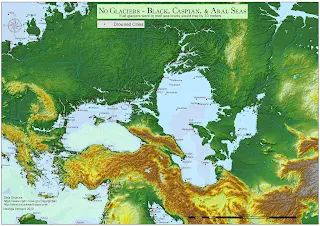If every continental and mountainous glacier were to vanish, sea levels would rise by around 70 meters (230 feet).
It's an inevitability but on a geologic time frame, not a human one.
Ultimately, the different orbital cycles that are tied for large-scale climate periods will bring us out of our modern ice age, and Antarctica and Greenland will have their forests return.
Today we are in an ice age, and most of our development has taken place in the warm interglacial period we are currently undergoing. The fact that we still have polar ice is an indicator that we are still in an ice age despite the last 12 thousand or more mild temperatures. The current interglacial is a little longer than most of them have been in the previous 400 thousand years and would likely be coming to a close relative shortly. Still, human activities in the last one hundred or so years have altered the climate dynamic. Notwithstanding our actions, we are doubtful to approach the sea levels shown in these maps due to human activities.
It's an inevitability but on a geologic time frame, not a human one.
Ultimately, the different orbital cycles that are tied for large-scale climate periods will bring us out of our modern ice age, and Antarctica and Greenland will have their forests return.
Today we are in an ice age, and most of our development has taken place in the warm interglacial period we are currently undergoing. The fact that we still have polar ice is an indicator that we are still in an ice age despite the last 12 thousand or more mild temperatures. The current interglacial is a little longer than most of them have been in the previous 400 thousand years and would likely be coming to a close relative shortly. Still, human activities in the last one hundred or so years have altered the climate dynamic. Notwithstanding our actions, we are doubtful to approach the sea levels shown in these maps due to human activities.














This post may contain affiliate links. As an Amazon Associate, I earn from qualifying purchases.